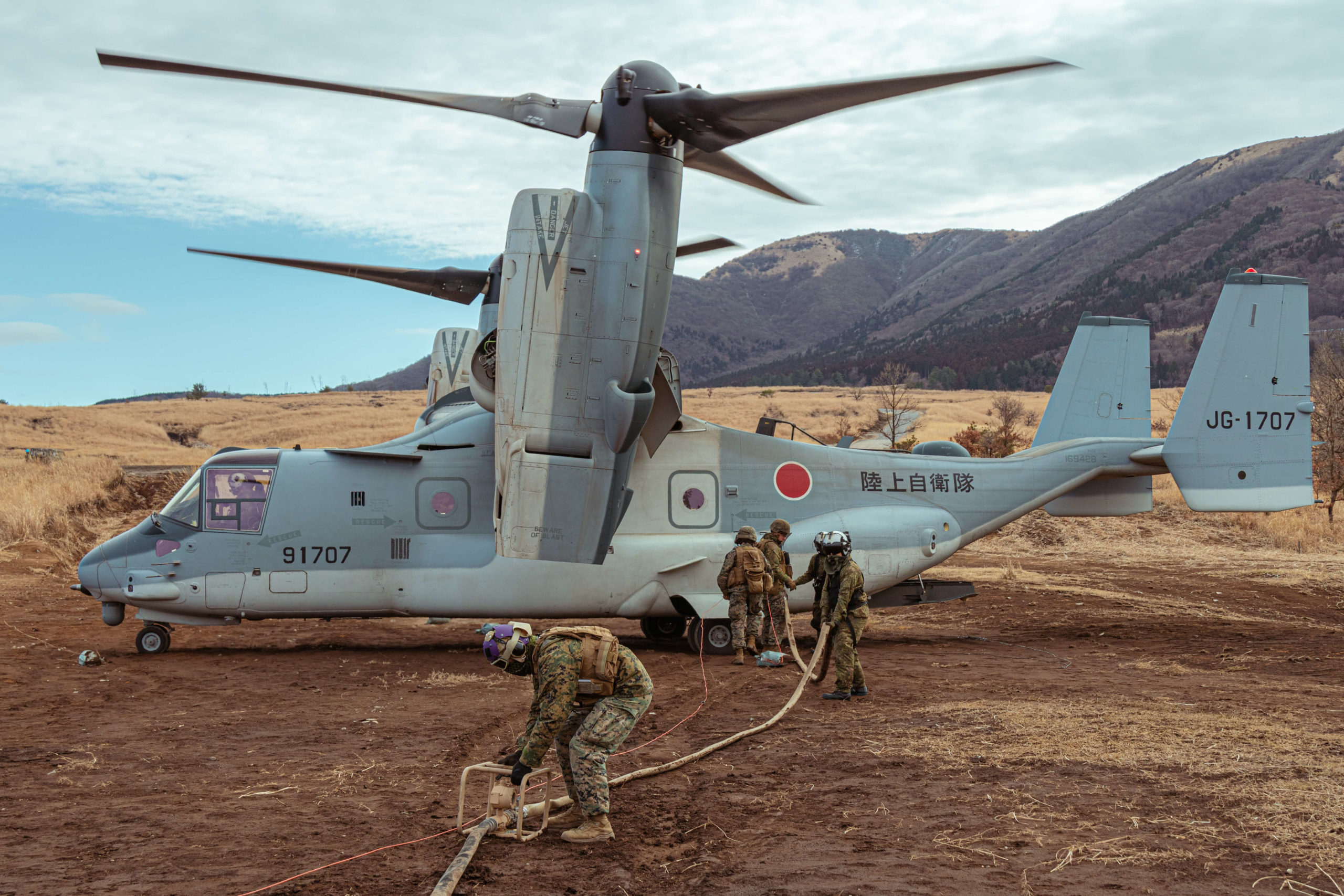Japan Establishes a New Osprey Base: A Strategic Move to Counter China’s Expansionist Policies
Japan’s Ground Self-Defense Force (GSDF) opened a new chapter in its defense strategy on July 9, 2025, with the inauguration of Camp Saga and the beginning of a major military redeployment that positions the nation’s entire V-22 Osprey fleet closer to potential flashpoints in the East China Sea.
The first of Japan’s 17 tilt-rotor aircraft arrived at the newly constructed base in Saga Prefecture on Kyushu island, marking the beginning of a relocation process that will be completed by mid-August. The deployment represents a significant shift from the aircraft’s temporary home at Camp Kisarazu near Tokyo, where they had been stationed since 2020.
The relocation to Camp Saga places Japan’s Ospreys in optimal position to defend the country’s southwestern island chain, particularly the disputed Senkaku Islands claimed by China. Defense Minister Gen Nakatani emphasized the urgency of this capability enhancement, stating that “the security environment surrounding Japan has been increasingly severe, and it is our pressing task to strengthen our island defense capabilities”.
The strategic value of the new positioning becomes clear when considering regional geography. Camp Saga sits just 45 miles from Camp Ainoura in Sasebo, where Japan’s Amphibious Rapid Deployment Brigade is based. This proximity enables coordination between Japan’s elite amphibious forces and their primary means of rapid deployment to contested areas.
The Ospreys become the tip of the spear so to speak, and, frankly, I would not be surprised to see Japan add maritime autonomous systems to their force to enhance their ability to project distributed effects further forward.
Far too often the Taiwan issue is seen as some residual U.S.-Chinese confrontation. It is not. The Japan-Taiwan-Philippines triangle is a key part of Japanese security and the Chinese asserting their old imperial claims to Taiwan are not part of a legitimate Chinese security policy but part of their effort to craft a new global security policy to their advantage.
The timing of this deployment coincides with escalating Chinese military activities in the region. In June 2025, China conducted Pacific military drills involving both of its aircraft carriers, the Shandong and Liaoning, for the first time, with Chinese fighter jets coming within 150 feet of Japanese patrol aircraft during the exercises.
The Osprey deployment forms a cornerstone of Japan’s military buildup, which includes a defense budget exceeding 7 trillion yen for fiscal year 2025 which is the largest postwar military spending plan in Japanese history. This represents a fundamental shift in Japan’s defense posture, moving from a largely reactive stance to one emphasizing rapid response and deterrence.
The new Camp Saga facility reflects this commitment to enhanced military capability. Built on former farmland west of Saga Airport, the base includes state-of-the-art aircraft hangars, ammunition storage facilities, fuel tanks, and dual runway access roads. The installation will house between 700 and 800 personnel, including approximately 420 assigned specifically to the Osprey wing.
Beyond the Ospreys, Camp Saga is expected to absorb 50 helicopters currently stationed at nearby Camp Metabaru, creating a consolidated air mobility hub for southwestern Japan. This concentration of assets enables coordinated operations with air force and navy personnel based throughout the region.
The V-22 Osprey’s unique capabilities make it particularly valuable for Japan’s island defense strategy. Unlike conventional helicopters, the tilt-rotor aircraft can take off and land vertically while cruising at airplane speeds, providing unmatched flexibility for rapid deployment across Japan’s scattered southwestern islands.
Prime Minister Shigeru Ishiba highlighted these capabilities during a campaign speech in Saga, noting that Ospreys are “significantly superior to conventional helicopters” and can “bolster Japan’s security and disaster relief operations”. This dual-use capability for both military and humanitarian missions provides Japan with versatile assets for various contingencies.
The deployment strategy reflects lessons learned from recent regional tensions. The proximity to Taiwan, where Beijing’s military presence has surged, makes rapid response capability crucial for maintaining regional stability. The Osprey fleet provides Japan with the ability to reinforce its southwestern islands quickly, serving as a deterrent against potential blockades or amphibious incursions.
The Camp Saga deployment signals Japan’s commitment to active defense of the Indo-Pacific region, complementing U.S. forward-deployed forces in Okinawa and elsewhere. This capability enhancement comes as China continues to challenge the existing regional order through increasingly assertive maritime actions around disputed territories.
The strategic positioning also reflects Japan’s broader shift toward proactive island defense, moving beyond traditional homeland security to encompass protection of remote territories that could serve as stepping stones for potential adversaries.
This approach recognizes that modern conflict scenarios may require rapid response to prevent fait accompli situations.
Camp Saga represents more than just a military base relocation of is Ospreys.
It embodies Japan’s determination to maintain peace through strength, ensuring that any potential aggressor must account for Japan’s enhanced ability to respond swiftly and decisively to threats against its territory and interests.
Featured photo: U.S. Marines with Marine Medium Tiltrotor Squadron 262 (Reinforced), 31st Marine Expeditionary Unit, and soldiers with the 1st Regimental Landing Team supporting the 1st Amphibious Rapid Deployment Regiment, Japan Ground Self-Defense Force, refuel a 1st Helicopter Brigade, JGSDF V-22 Osprey at a forward arming and refueling point during Iron Fist 23 at Hijudai, Japan, Feb. 17, 2023. Marines utilized the FARP as a point of operation to refuel and rearm aircraft outside of a forward operating base/ (U.S. Marine Corps photo by Cpl. Vincent Pham).
See also the following:
Deterrence in Depth: From Japan to Amarillo, the Case of the Osprey
A Paradigm Shift in Maritime Operations: Autonomous Systems and Their Impact

